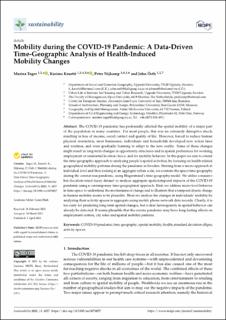| dc.contributor.author | Toger, Marina | |
| dc.contributor.author | Kourtit, Karima | |
| dc.contributor.author | Nijkamp, Peter | |
| dc.contributor.author | Östh, John | |
| dc.date.accessioned | 2023-01-27T10:11:57Z | |
| dc.date.available | 2023-01-27T10:11:57Z | |
| dc.date.created | 2022-02-03T12:14:20Z | |
| dc.date.issued | 2021-04-05 | |
| dc.identifier.citation | Sustainability. 2021, 13 (7), . | en_US |
| dc.identifier.issn | 2071-1050 | |
| dc.identifier.uri | https://hdl.handle.net/11250/3046805 | |
| dc.description.abstract | The COVID-19 pandemic has profoundly affected the spatial mobility of a major part of the population in many countries. For most people, this was an extremely disruptive shock, resulting in loss of income, social contact and quality of life. However, forced to reduce human physical interaction, most businesses, individuals and households developed new action lines and routines, and were gradually learning to adapt to the new reality. Some of these changes might result in long-term changes in opportunity structures and in spatial preferences for working, employment or residential location choice, and for mobility behavior. In this paper we aim to extend the time-geographic approach to analyzing people’s spatial activities, by focusing on health-related geographical mobility patterns during the pandemic in Sweden. Starting from a micro-approach at individual level and then looking at an aggregate urban scale, we examine the space-time geography during the coronavirus pandemic, using Hägerstrand’s time-geography model. We utilize a massive but (location-wise) fuzzy dataset to analyze aggregate spatiotemporal impacts of the COVID-19 pandemic using a contemporary time-geographical approach. First, we address micro-level behavior in time-space to understand the mechanisms of change and to illustrate that a temporal drastic change in human mobility seems to be plausible. Then we analyze the changes in individuals’ mobility by analyzing their activity spaces in aggregate using mobile phone network data records. Clearly, it is too early for predicting long-term spatial changes, but a clear heterogeneity in spatial behavior can already be detected. It seems plausible that the corona pandemic may have long-lasting effects on employment centers, city roles and spatial mobility patterns. | en_US |
| dc.language.iso | eng | en_US |
| dc.publisher | MDPI | en_US |
| dc.relation.ispartofseries | Sustainability;Volume 13 / Issue 7 | |
| dc.rights | Navngivelse 4.0 Internasjonal | * |
| dc.rights.uri | http://creativecommons.org/licenses/by/4.0/deed.no | * |
| dc.subject | COVID-19 pandemic | en_US |
| dc.subject | Time geography | en_US |
| dc.subject | Spatial mobility | en_US |
| dc.subject | Health | en_US |
| dc.subject | Standard deviation ellipse | en_US |
| dc.subject | Activity spaces | en_US |
| dc.title | Mobility during the COVID-19 Pandemic: A Data-Driven Time-Geographic Analysis of Health-Induced Mobility Changes | en_US |
| dc.type | Peer reviewed | en_US |
| dc.type | Journal article | en_US |
| dc.description.version | publishedVersion | en_US |
| dc.rights.holder | © 2021 by the authors | en_US |
| dc.source.articlenumber | 4027 | en_US |
| cristin.ispublished | true | |
| cristin.fulltext | original | |
| cristin.qualitycode | 1 | |
| dc.identifier.doi | https://doi.org/10.3390/su13074027 | |
| dc.identifier.cristin | 1997349 | |
| dc.source.journal | Sustainability | en_US |
| dc.source.volume | 13 | en_US |
| dc.source.issue | 7 | en_US |
| dc.source.pagenumber | 1-21 | en_US |

